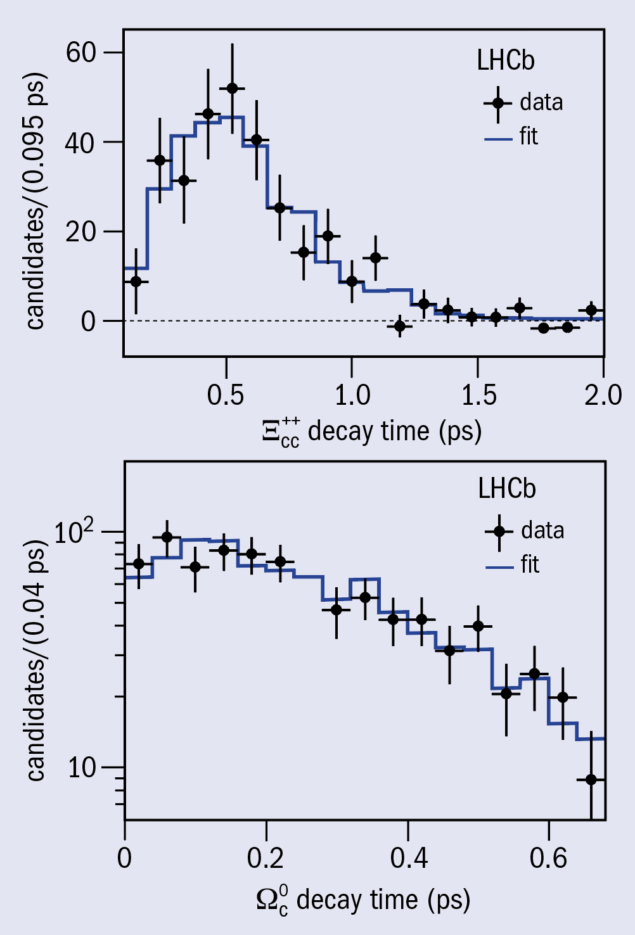
Last year, the LHCb collaboration announced the first observation of the Ξcc++ baryon, a doubly charmed particle (CERN Courier July/August 2017 p8). It was identified via the decay Ξcc++ → Λc+ K–π+π+, with the Λc+ baryon subsequently decaying to pK–π+. Since then, LHCb has carried out a campaign of further studies to pinpoint the properties of this special particle, namely looking for additional Ξcc++ decays and, more importantly, measuring its lifetime.
LHCb has now reported a first measurement of the Ξcc++ lifetime, exploiting the same decay mode and using a data sample and an event selection similar to those used in the first observation. The experimental technique used is to measure the decay-time distribution relative to that of another decay with a similar topology, Λb0 → Λc+π–π+π–. As the lifetime of the Λb0 is already known with high precision from previous measurements, once the ratio of efficiencies for reconstructing the Ξcc++ and Λb0 decays is determined, it is possible to derive the lifetime of the Ξcc++ baryon from its decay-time distribution (see figure).
The lifetime value that is obtained is 256+24 –22 (stat) ± 14 (syst) fs. Relatively large lifetimes like this are a distinctive feature of weak interactions. In addition, LHCb has also observed a new Ξcc++ decay: Ξcc++ → Ξc+π+, with a statistical significance of about six standard deviations, thus confirming the first observation of Ξcc++ in an independent analysis. The baryon’s mass is measured to be 3620.6 ± 1.5 (stat) ± 0.5 (syst) MeV/c2, which is consistent with the previous result.
Turning to a separate analysis, a puzzling result has emerged at LHCb while measuring the lifetime of another charmed baryon: the Ωc0. The sample of LHCb data used for this measurement comprises about 1000 Ωb− → Ωc0μ−νμX signal decays, where the Ωc0 baryon is detected via the decay Ωc0 → pK−K−π+ and X represents possible additional undetected particles in the decay. The Ωc0 lifetime is determined from the observed decay-time distribution to be 268 ± 24 (stat) ± 10 (syst) fs (see figure).
Quite surprisingly, this value is nearly four times larger than, and inconsistent with, the current world average of 69 ± 12 fs. This average is based on three experimental results from fixed-target experiments, namely E687, FOCUS and WA89, where each experiment observed only a few dozen events with relatively large background. The new measurement from LHCb redefines the lifetime hierarchy of charmed baryons, placing the Ωc0 baryon as having the second largest lifetime after the Ξc+ baryon, i.e. τ(Ξc+) > τ(Ωc0) > τ(Λc+) > τ(Ξc0). This result may lead to reconsideration of the relative importance of the roles of spectator quarks and of non-perturbative effects in the decay dynamics of hadrons containing heavy quarks.
Further reading
LHCb Collaboration 2018 LHCb-PAPER-2018-019.
LHCb Collaboration 2018 LHCb-PAPER-2018-026.
LHCb Collaboration 2018 LHCb-PAPER-2018-028.





